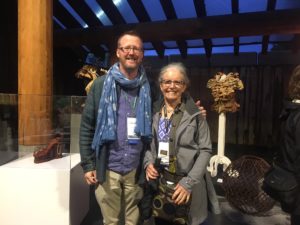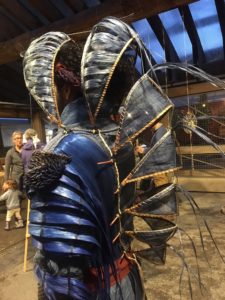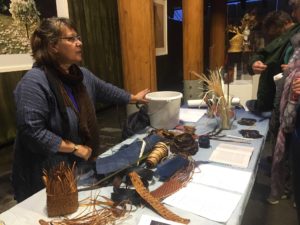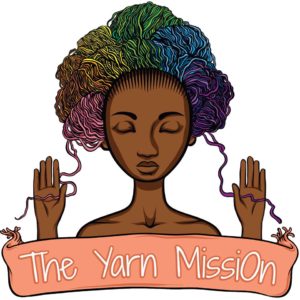“SDA Convening at TSA Symposium” by Lila Stone
October 24, 2018
The Textile Society of America’s 16th Biennial Symposium The Social Fabric: Deep Local to Pan Global was held in Vancouver, Canada from September 19–23. The conference consisted of concurrent sessions for maximum enjoyment of top-notch content, keynote and plenary speakers, poster sessions, and all sorts of well orchestrated surface design related events.
There was one particular Friday night event, Evening at Granville Island, that was rife with members of the SDA community, including but not limited to Astrid Bennett, SDA President, Thomas Roach, SDA BC Representative, and myself, SDA Membership Manager. Granville Island is a place that reminded me a bit of Coney Island but imagine less ferris wheel, more art. It is said to be the cultural heartbeat of Vancouver; known for its concentrated pedestrian area chalk full of galleries, art shops, and exhibition spaces. The Silk Weaving Studio, Craft Council of BC, and Circle Craft Cooperative all staged special exhibits for the evening which drew crowds of conference attendees.

Thomas Roach and Astrid Bennett, Granville Island, Vancouver, 2018
Award winning artist and environmentalist, Vancouver-based Nicole Dextras designed and executed a costume especially for the Granville Island tour. Dextra fashions exquisite costumes, working with natural products, like flowers and vegetables to hint at our essential connection to the environment around us. Her work was featured on the cover for the Winter 2017 edition of Surface Design Journal: “Future Fabrication: SDA International Exhibition in Print”. The man adorning costume was jovial and ready to smile for a picture; I don’t doubt he was partly chosen for his role for his amicable nature. Dextras was simultaneously fielding questions and performing a demonstration for interested onlookers.

Nicole Dextras, costume for Granville Island, Vancouver, 2018

Nicole Dextras, Granville Island, Vancouver, 2018
On Saturday morning, I had the pleasure of presenting research in the Social Justice group on expanded research from an article I wrote for Surface Design Journal’s “Made/Aware” department of the Summer 2017 edition. My presentation, “The Radical Fiber Arts Practices of The Yarn Mission: A Case Study,” investigated how The Yarn Mission uses fiber arts practices to challenge racism and sexism through the lens of a case study and using qualitative research. The Yarn Mission is a “pro-Black, pro-rebellion, pro-community” knitting collective that formed in St. Louis, Missouri, in response to the tragic death of Mike Brown at the end of 2014. The collective began as a way for Black women to share space off of the streets and outside of demonstrations and began to grow organically as founder CheyOnna Sewell and early members taught interested collaborators—others with similar values—how to knit.

Yarn Mission Logo
“Art making has a way to help us identify those systems that are oppressing us… and in some way these systems are becoming invisible. It is a way to really examine the structures that exist. To name them is to be able to transform them,” said Maria Asp, a member of The Yarn Mission in Minneapolis during an oral history interview in March 2018. Their mission is to decenter whiteness and empower Black workers and support Black workers’ rights. They have a social responsibility, a conscious consumerist policy that pushes them to “pay Black women.” While the pieces themselves, can seem innocuous at first glance, if you look deeper you realize the knitted clothing items are steeped in shared stories. It is as if the knits and pearls, and the tightening and loosening of them, reflect and mirror the anxiety and unease of the complex history of civil rights, police brutality, and and also the individual and shared process of mending. The question is to what end do these wares, these knitted items, serve as a reminder of the pervasive inequality in our societies today?
The Sheraton Wall Centre in downtown Vancouver, where the conference was staged, was like a city unto itself; the glass-walled building was constantly buzzing with excitement for five days as attendees rushed to get to the next presentation.
Lila Stone is an arts professional with a knack for explaining the process. She works and volunteers for a slew of tight knit organizations including SDA and TSA.

Related Blog Articles
Astrid Bennett
Learn More: “Textile Narratives, Vintage, Found & Transformed” with Maggy Rozycki Hiltner, Susan Lenz & Jennifer Lee Morrow
Astrid Bennett
“International Shibori Symposium 2018 Review (Part II)” by Astrid Bennett & Kim Eichler-Messmer
Astrid Bennett
“International Shibori Symposium 2018 Review (Part I)” by Astrid Bennett & Kim Eichler-Messmer